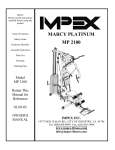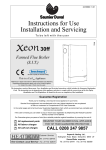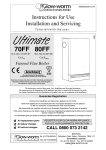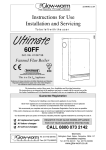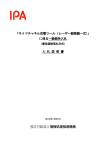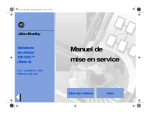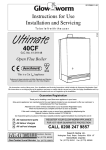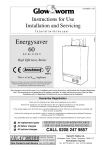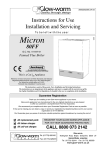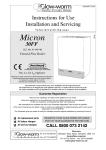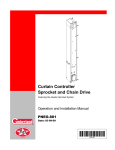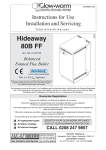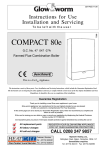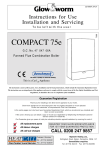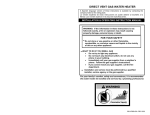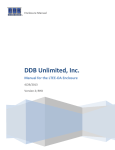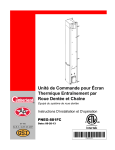Download Glow worm Ultimate 100FF free boiler manual
Transcript
221966B.12.04 Instructions for Use Installation and Servicing 4272 To b e l e f t w i t h t h e u s e r 100FF 120FF G.C. No. 41 047 59 G.C. No. 41 319 75 Fanned Flue Boiler BS 6332 BS 5258 This is a Cat I2H Appliance Reference in these instructions to British Standards and Statutory Regulations/Requirements apply only to the United Kingdom. For Ireland the rules in force must be used. The instructions consist of three parts, User, Installation and Servicing Instructions. The instructions are an integral part of the appliance and must, to comply with the current issue of the Gas Safety (Installation and Use) Regulations, be handed to the user on completion of the installation. Guarantee Registration Thank you for installing a new Glow-worm appliance in your home. Glow-worm appliances' are manufactured to the very highest standard so we are pleased to offer our customers' a Comprehensive First Year Guarantee. We recommend you complete and return your Guarantee Registration Card as soon as possible. If this card is missing you can obtain a copy or record your registration by telephoning the Glow-worm Customer Service number 01773 828100. Our Guarantee gives you peace of mind plus valuable protection against breakdown by covering the cost of: ✔ ❏ ✔ ❏ ✔ ❏ All replacement parts All labour charges All call-out charges REGISTER YOUR GLOW-WORM APPLIANCE FOR 1ST YEAR GUARANTEE PROTECTION CALL 0800 073 2142 Tel: (01773) 828100 Fax: (01773) 828070 Glow-worm, Nottingham Road, Belper, Derbyshire. DE56 1JT General/Sales enquiries: Tel: (01773) 824141 Fax: (01773) 820569 www.glow-worm.co.uk Important Information Testing and Certification This boiler is tested and certificated for safety and performance. It is therefore important that no alteration is made to the boiler, without permission, in writing, from Glow-worm. Any alteration not approved by Glow-worm, could invalidate the certification, boiler warranty and may also infringe the current issue of the Statutory Requirements, see Section 1.4. CE Mark This boiler meets the requirements of Statutory Instrument No. 3083 The boiler (Efficiency) Regulations, and therefore is deemed to meet the requirements of Directive 92/42/EEC on the efficiency requirements for new hot water boilers fired with liquid or gaseous fuels. Type test for purposes of Regulation 5 certified by: Notified body 0086. Product/productioncertifiedby: Notified body 0086. The CE mark on this appliance shows compliance with: 1. Directive 90/396/EEC on the approximation of the laws of the Member States relating to appliances burning gaseous fuels. 2. Directive 73/23/EEC on the harmonization of the Laws of the Member States relating to the electrical equipment designed for use within certain voltage limits. 3. Directive 89/336/EEC on the approximation of the Laws of the Member States relating to electromagnetic compatibility. INFORMATION FOR THE INSTALLER AND SERVICE ENGINEER. Under Section 6 of The Health and Safety at Work Act 1974, we are required to provide information on substances hazardous to health. REFRACTORY CERAMIC FIBRE This product uses insulation material containing Refractory Ceramic Fibre (RCF), which are man-made vitreous silicate fibres. Excessive exposure to these materials may cause temporary irritation to eyes, skin and respiratory tract, consequently, it makes sense to take care when handling these articles to ensure that the release of dust is kept to a minimum. To ensure that the release of fibres from these RCF articles is kept to a minimum, during installation and servicing we recommend that you use a HEPA filtered vacuum to remove any dust accumulated in and around the boiler before and after working on the boiler. When replacing these articles we recommend that the replaced items are not broken up, but are sealed within heavy duty polythene bags, clearly labelled as RCF waste. This is not classified as “hazardous waste” and may be disposed of at a tipping site licensed for the disposal of industrial waste. Protective clothing is not required when handling these articles, but we recommend you follow the normal hygiene rules of not smoking, eating or drinking in the work area and always wash your hands before eating or drinking. INSULATION PADS, GLASSYARN. These can cause irritation to skin, eyes and the respiratory tract. If you have a history of skin complaint you may be susceptible to irritation. High dust levels are usual only if the material is broken. Normal handling should not cause discomfort, but follow normal good hygiene and wash your hands before eating, drinking or going to the lavatory. If you do suffer irritation of the eyes or severe irritation to the skin seek medical attention. THERMOSTATS These contain very small amounts of xylene in the sealed phial and capillary. If broken, under normal circumstances the fluid does not cause a problem, but in case of skin contact, wash with cold water. If swallowed drink plenty of water and seek medical attention CUT-OFF DEVICES These contain activated charcoal and a very small amount of chlorodifluormethane in the sealed phial and capillary. If broken, under normal circumstances the fluid does not cause a problem. If there is irritation to the eyes or skin then seek medical attention. Spare Parts REMEMBER: When replacing a part on this appliance, use only spare parts that you can be assured conform to the safety and performance specification that we require. Do not use reconditioned or copy parts that have not been clearly authorised by Glowworm. 221966B 2 Important Information CONTENTS INSTRUCTIONS FOR USE INSTALLATION INSTRUCTIONS SERVICING INSTRUCTIONS DESCRIPTION SECTION Introduction Lighting the Boiler PAGE No. 3 5 General Data Flue Terminal Water Systems Flue and Appliance Preparation Boiler Installation Flue Fixing Electrical Connectors Commissioning Instructions to the User 1 2 3 4 5 6 7 8 9 6 9 10 13 17 19 20 21 24 Servicing Fault Finding Replacement of Parts Spare Parts 10 11 12 13 24 27 31 34 Instructions for Use Introduction Gas Leak or Fault WARNING: It is important that the case (not the controls tray) is not disturbed or removed other than for servicing by a competent person. Turn off the gas emergency control valve immediately. Eliminate all sources of ignition, i.e.smoking, blowlamps, hot air guns etc. Do not operate electrical lights or switches either on or off. Open all doors and windows,ventilate the area. The user shall not interfere with or adjust sealed parts. Electrical Supply Failure Please read these instructions and follow them carefully for the safe and economical use of your boiler. Failure of the electrical supply will cause the burner to go out. Should this occur, operation of the appliance will normally resume after the electrical supply is restored. The Ultimate FF series are fanned flue boilers designed to provide central heating and indirect domestic hot water. The boiler is fully automatic in operation having only one user control, the control thermostat. If the boiler does not relight after an electrical supply failure the overheat safety cutoff device may need resetting, remove the controls cover and press the reset button, refer to diagram 1. IMPORTANT NOTICE This boiler is for use only on natural gas (G20). Overheat Safety Cutoff The Gas Safety (Installation and Use) Regulations If the overheat safety cutoff device operates on any other occasion than an electrical supply failure, press the reset button as in “Electrical Supply Failure”. If the overheat operates again, turn the appliance off and contact your installation/servicing company. In your interest and that of gas safety it is the law that ALL gas appliances are installed by a competent person in accordance with the above regulations. 3 221966B Instructions for Use 4140 Maintenance CONTROLS COVER To ensure the continued efficient and safe operation of the boiler it is recommended that it is checked and serviced as necessary at regular intervals. The frequency of servicing will depend upon the particular installation conditions and usage, but in general once a year should be enough. If this appliance is installed in a rented property in the UK there is a duty or care imposed on the owner of the property by the current issue of The Gas Safety (Installation and Use) Regulations, Section 35. It is the law that any servicing is carried out by a competent person. To obtain service, please call your installer or Glow-worm’s own Service Organisation using the telephone number given on the controls tray. 30FF to 60FF Ultimate User Controls illustrated, details for the 70FF to 120FF are different but the controls are the same. Please be advised that the ‘Benchmark’ logbook should be completed by the installation engineer on completion of commissioning and servicing. 4625 All CORGI Registered Installers carry a CORGI ID card, and have a registration number. Both should be recorded in your boiler Logbook. You can check your installer is CORGI registered by calling CORGI direct on :- 01256 372300. DATA & SERIAL NUMBER LABEL VIEWING WINDOW RESET BUTTON Boiler Clearances If fixtures are positioned close to the boiler space must be left as shown in diagram 2. At least a minimum clearance of 500mm must be left in front of the boiler to allow for servicing. Boilers Installed in a Compartment or Cupboard If the boiler is installed in a compartment or cupboard do not obstruct any ventilation openings. Do not use the compartment or cupboard for storage. CONTROL THERMOSTAT KNOB GAS SERVICE Cleaning WARNING: This appliance contains metal parts (components) and care should be taken when handling and cleaning, with particular regard to edges. SETTING POINT COCK (Shown Off) Clean the casing occasionally by wiping it over with a damp cloth or dry polishing duster. Diagram 1 Do not use an abrasive cleaner. Boiler Electrical Supply WARNING: This boiler must be earthed. The colours of three core flexible cable are: The boiler must only be connected to a 230V~50Hz supply protected by a 3A fuse. Brown - live, Blue - neutral, All system components shall be of an approved type and shall be connected in accordance with the current issue of BS7671 and any applicable local regulations. As the markings on your plug may not correspond with these colours continue as follows: Green/yellow - earth. External wiring must be correctly earthed, polarised and in accordance with the relevant standards. The cable coloured blue must be connected to the terminal marked “N” or black. In GB this is BS 6891. The cable coloured brown must be connected to the terminal marked “L” or red. In IE this is the current edition of I.S.813 "Domestic Gas Installations". The cable coloured green/yellow must be connected to the terminal marked “E”, or green or the earth symbol . Wiring to the boiler must be PVC insulated type to the current issue of BS6500 Table 16, not less than 0.75mm2 (24/0.20mm). 221966B 4 Instructions for Use 0208M To Light the Boiler WARNING: Sealed Systems Do not operate the boiler wthout water. A sealed water system must be filled and pressurised by a competent person. 6mm 6mm Only light the boiler when you are sure that the system has been filled and pressurised. The pressure gauge should show at least 0.7bar, anything less than this figure could indicate a leak and you MUST contact your installation/servicing company. 500mm Additional clearances may be required for installation If there is any doubt about the boiler being full of water consult your installation/servicing company. ALL SYSTEMS: 6mm 160mm Turn the electrical supply on to the boiler and check that all remote controls are calling for heat. To Turn the Boiler On Remove the controls cover, by withdrawing it forward and off, see diagram 1. 6mm 6mm Turn the control thermostat knob clockwise to any position between MIN and MAX. The maximum temperature setting is about 82oC (180oF), see diagram 1. FRONT VIEW The boiler lighting operation is now automatic as follows. The fan operates, followed by an ignition spark until the pilot is lit. When the pilot is alight the ignition system switches off and the main burner lights. The flames can be seen through the viewing window, see diagram 1. 65mm The main burner will remain alight until switched off by the control thermostat or any remote control. Diagram 2 If the boiler is switched OFF, by hand, wait at least 30 seconds before switching on again. When the boiler switches off, both the pilot and main burner go out. The automatic lighting sequence will operate again when heat is required. Refit the controls cover. It should be noted that this is a fan flue appliance and fan operation may be heard. To Turn the Boiler Off For short periods, turn the control thermostat knob anti-clockwise to “O” Off. To relight, turn the control thermostat knob to any position between “MIN” and “MAX”. For longer periods, turn the control thermostat knob fully anticlockwise to “O” Off and switch off the electrical supply to the boiler. To relight follow the lighting sequence given above. Protection Against Freezing. If the boiler is to be out of use for any long period of time during severe weather conditions we recommend that the whole of the system, including the boiler, be drained off to avoid the risk of freezing up. Make sure that, if fitted, the immersion heater in the cylinder is switched off. For the position of the serial number, see diagram 1. 5 221966B O F G H E P CL D J 0301M C A PUMPED RETURN PUMPED FLOW ;; ; B 1 General WATER CONNECTIONS 28mm COPPER PIPE K GAS CONNECTIONS RC1/2 (1/2 in. BSPT) L M SIDE ELEVATION FRONT ELEVATION MODEL A B C D E F G H J K L M O P 100FF,120FF 67 300 58 127 114 450 168 132.5 835 772 63 132 43 78.5 Diagram 1.1 The Health and Safety at Work Act, Control of Substances Hazardous to Health (COSHH). IMPORTANT NOTICE This boiler is for use on Natural Gas (G20) as distributed in the United Kingdom and Ireland and cannot be used on any other gas. This boiler must be installed by a competent person ONLY. The Current I.E.E. Wiring Regulations. Where no specific instructions are given, reference should be made to the relevant British Standard Code of Practice. This boiler can be used on open vented or sealed water systems. In IE, the installation must be carried out by a competent person and installed in accordance with the current edition of I.S.813 "Domestic Gas Installations", the current Building Regulations and reference should be made to the current ETCI rules for Electrical Installation. When used on an open vented system domestic hot water can only be provided by pumped circulation to the indirect cylinder. Wherever possible, all materials, appliances and components used shall comply with the requirements of applicable British Standards. In GB the following Codes of Practice apply: BS4814, BS6798, BS5440 Part 1 and 2, BS5546 Part 1, BS5449, BS6891, BS6700, BS7074 Part 1 and 2, BS7593, BS7671. Where no British Standard exists, materials and equipment should be fit for their purpose and of suitable quality and workmanship. In IE: I.S.813, BS5546, BS 5449, BS 7074, BS 7593. Refer to Manual Handling Operations, 1992 regulations. Manufacturer’s instructions must not be taken as overriding statutory requirements. Sheet Metal Parts 1.2 Data WARNING: When installing or servicing this boiler care should be taken when handling sheet metal parts, to avoid any possibility of personal injury. See Table 1 All dimensions are given in millimetres (except as noted). 1.1 Statutory Requirements *NOTE: Lift weight is with Flue Elbow, Controls Cover and Front Cover removed. In GB the installation of the boiler must be carried out by a competent person as described in the following regulations: The Seasonal Efficiency Domestic Boilers UK (SEDBUK) is Ultimate 100FF = 79, Ultimate 120FF = 78.1. The manufacturer’s instructions supplied. The value is used in the UK Government’s Standard Assessment Procedure (SAP) for energy rating of dwellings. The test data from which it has been calculated have been certified by B.S.I. The Gas Safety (Installation and Use) Regulations. The appropriate Buildings Regulations either The Building Regulations, The Building Regulations (Scotland),The Building Regulations (Northern Ireland). 1.3 Range Rating This boiler is range rated and may be adjusted to suit individual system requirements. The Water Fittings Regulations or Water byelaws in Scotland. Table 2 gives the ratings and settings. 221966B 6 MODEL TABLE 2. 9072 DATA TABLE 1. 120FF TOTAL DRY WEIGHT (Including Terminal) 71.0 kg (157 lb) 71.0 kg (157 lb) NOMINAL HEAT INPUT(NETT) *LIFT WEIGHT 63.3 kg (140 lb) 63.3 kg (140 lb) NOMINAL HEAT OUTPUT WATER CONTENT 3.8 litres (0.84 gal) 3.8 litres (0.84 gal) GAS CONNECTION 71W 97W Internal fuse F1 & F2 (F1A) WATER CONNECTION 2x28mm copper pipes from top of case ELECTRICITY SUPPLY 230V~50Hz, fused 3A DATA LABEL Bottom right hand side of case Min. kW Btu/h kW Btu/h BURNER. m bar SETTING PRESSURE in. wg. Rc 1/2 in. ELECTRICITY RATING 100FF RANGE RATING 100FF APPROX. GAS RATE m3/h 3 ft /h APPROX. GAS RATE In GB this is BS6891. In IE this is the current edition of I.S.813 "Domestic Gas Installations". The supply from the governed meter must be of adequate size to provide a steady inlet working pressure of 20mbar (8in wg) at the boiler. 9.2 3.7 11.6 4.7 14.4 5.8 2.8 100 3.1 111 3.5 123 120FF Min. kW Btu/h kW Btu/h BURNER. m bar SETTING PRESSURE in. wg. The gas installation shall be in accordance with the relevant standards. 23.45 29.31 26.38 80,000 90,000 100,000 4.7mm NOMINAL HEAT OUTPUT 1.5 Gas Supply 29.24 32.38 99,760 110,485 BURNER INJECTOR SIZE: NOMINAL HEAT INPUT(NETT) Any alteration that is not approved by Glow-worm, could invalidate the B.S.I. Certification of the boiler, warranty and could also infringe the current issue of the Statutory Requirements. Max. 205727 RANGE RATING This boiler is certificated to the current issue of BS6332 Part 1, invoking the current issue of BS5258 Part 1 for performance and safety. It is, therefore, important that no alteration is made to this boiler without permission, in writing, from Glow-worm. 26.44 90,210 Med. BURNER INJECTOR MARKING: TABLE 2. 1.4 B.S.I. Certification 9715 1 General m3/h 3 ft /h Medium. Max. 33.43 39.6 36.52 114,066 124,608 135,150 29.3 35.17 32.24 100,000 110,000 120,000 9.9 4.0 12.0 4.8 14.2 5.7 3.5 125 3.9 137 4.2 148 BURNER INJECTOR MARKING: 205726 BURNER INJECTOR SIZE: 5.2mm of 3mm on both poles. The switch should be readily accessible and preferably adjacent to the appliance. It should supply the appliance only and be easilyidentifiable as so doing. On completion test the gas installation using the pressure drop method and suitable leak detection fluid, purge in accordance with the current issue of BS6891. Alternatively, an unswitched shuttered socket outlet and 3A fused 3 pin plug both to the current issue of BS1363 may be used, provided that they are not used in a room containing a bath or shower. 1.6 Electrical Supply WARNING: This boiler must be earthed. All system components shall be of an approved type and shall comply with and be connected in accordance with the current issue of BS7671 and any applicable local regulations. Wiring to the boiler must be PVC insulated type to the current issue of BS6500 Table 16. External wiring must be correctly earthed, polarised and in accordance with the relevant standards. 1.7 Contents of Packaging In GB this is BS 6891. The boiler is delivered in one pack, refer to Section 4.1 for contents. In IE this is the current edition of I.S.813 "Domestic Gas Installations". Refer to Section 4.2 to check that the flue terminal assembly supplied is suitable. Connection of the boiler and system controls to the mains supply must be through a common isolator and must be fused 3A, maximum. This method of connection must be by a fused double pole isolating switch with a minimum contact separation 1.8 Water System This boiler may be fitted to an open vented or sealed water system. 7 221966B 1 General 0208M It is recommended that plastic pipes for primary pipework should not be used for this boiler. 1.9 Drain 6mm 6mm System A draining tap must be provided at the lowest points of the system which will allow the entire system, boiler and hot water cylinder to be drained. PLAN VIEW 500mm Draining taps should be to the current issue of BS2879. Additional clearances may be required for installation Boiler A draining point is fitted at the bottom right hand side of the heat exchanger. 6mm 160mm Cover controls to avoid water damage. If required remove the combustion chamber front cover to improve access. 6mm 1.10 Safety Valve 6mm A safety valve need not be fitted to an open vented system. FRONT VIEW 1.11 Location This boiler is not suitable for outdoor installation. 65mm This boiler is suitable for installation in bathroom zones 2 and 3. The boiler may be installed in any room, although particular attention is drawn to the requirements of BS7671 with respect to the installation of a boiler in a room containing a bath or shower. Any electrical switch should be so positioned that it cannot be touched by a person using the bath or shower. The electrical provisions of the Building Standards (Scotland) Regulations apply to such installations in Scotland. 0209M MINIMUM CLEARANCES FROM WALLS CEILING, FLOOR, CUPBOARD, WORKTOPS, AND INFLAMMABLE MATERIALS Diagram 1.2 TABLE 3. COMPARTMENT AIR VENTS In GB this is the current I.E.E. WIRING REGULATIONS and BUILDING REGULATIONS. HIGH LEVEL VENT AREA LOW LEVEL VENT AREA cm2 in2 cm2 in2 VENTILATION 100FF FROM ROOM OR SPACE 330 51 330 51 120FF 396 61.5 396 61.5 VENTILATION 100FF FROM OUTSIDE 165 25.5 165 25.5 120FF 198 30.5 198 30.5 VENTILATION REQUIREMENTS In IE reference should be made to the current edition of I.S.813 "Domestic Gas Installations" and the current ETCI rules. MODEL The boiler must be mounted on a flat wall which is sufficiently robust to take its total weight. The boiler may be fitted to a wall made of combustible material. 1.12 Boiler Clearances Refer to diagram 1.2. The boiler must be positioned so that at least the minimum operational and servicing clearances are provided. Additional clearances may be required for installation. If fixtures are positioned next to the boiler they should be made removable for access to pipework. 1.15 Timber Frame Building Sufficient clearance must be left in front of the boiler for servicing. If the boiler is to be installed in a timber frame building it should be fitted in accordance with the Institute of Gas Engineers document IGE/UP/7/1998. If in doubt seek advice from the local gas undertaking or Glow-worm. 1.13 Room Ventilation The boiler is room sealed and does not require the room or space containing it to have permanent airvents. 1.16 Heating System Controls 1.14 Boilers in a Compartment The heating system should have installed: a programmer and room thermostat controlling the boiler. Where the installation of the boiler will be in an unusual position, special requirements are needed, the current issue of BS6798 gives detailed guidance on these requirements. Thermostatic radiator valves may be installed, however they must not be fitted in a room where the room thermostat is located. A compartment used to enclose the boiler must be designed and constructed specifically for this purpose. An existing cupboard or compartment modified for the purpose may be used. Details of essential requirements for cupboard or compartment design are given in the current issue of BS6798. NOTE: For further information, see the current issue of the Building Regulations, approved document L1, and the references: 1) GIL 59, 2000: Central heating system specification (CheSS) and The doorway opening should be of sufficient size to allow for easy removal of the boiler. 2) GPG 302, 2001: Controls for domestic central heating system and hot water. BRECSU. Where the boiler is fitted in a cupboard or compartment, permanent high and low level ventilation must be provided. The minimum ventilation areas are given in Table 3. 221966B 8 2 Flue Terminal 0103M NOTE: Detailed recommendations for flues are given in the current issue of BS5440 Part 1. 2.1 Terminal Position C A The minimum acceptable siting dimensions for the terminal from obstruction, other terminals and ventilation openings are shown in diagram 2.1. For Ireland the minimum distances for flue terminal positioning must be those detailed in I.S.813 "Domestic Gas Installations". B,C B,C G A F The terminal must be exposed to the external air, the position allowing free passage of air across it at all times. G K L K M F A E F G G G Car ports or similar extensions of a roof only, or a roof and one wall, require special consideration with respect to any openings, doors, vents or windows under the roof. Care is required to protect the roof if it is made of plastic sheeting. If the car port consists of a roof and two or more walls, seek advice from the local gas company before installing the boiler. L K Under Car Port etc. D J F K If the terminal is fitted within 600mm below plastic guttering or painted soffit an aluminium shield 1500mm long should be fitted immediately beneath the guttering or eaves. If the terminal is fitted within 450mm below painted eaves or a painted gutter, an aluminium shield 750mm long should be fitted immediately beneath the guttering or eaves. H,I MINIMUM SITING DIMENSIONS FOR FANNED FLUE TERMINALS POSITION 2.2 Terminal Guard MINIMUM SPACING in mm A DIRECTLY BELOW, ABOVE OR HORIZONTALLY A terminal guard is required if persons could come into contact with the terminal or the terminal could be subject to damage. TO AN OPENING, AIR BRICK, OPENING WINDOWS, AIR VENT OR ANY OTHER If a terminal guard is required, it must be positioned to provide a minimum of 50mm clearance from any part of the terminal and be central over the terminal. VENTILATION OPENING. 300 B BELOW GUTTER, DRAIN/SOIL PIPE A suitable guard, reference Type K3, can be obtained from: Tower Flue Components Ltd Morley Road Tonbridge Kent TN9 1RA 75 C BELOW EAVES 200 D BELOW A BALCONY OR CAR PORT 200 E FROM VERTICAL DRAIN PIPES AND SOIL PIPES 25 F FROM EXTERNAL CORNERS 25 G ABOVE ADJACENT GROUND OR BALCONY LEVEL 25 H FROM A SURFACE FACING THE TERMINAL I FACING TERMINALS 600 1200 J FROM OPENING (DOOR/WINDOW) IN CAR PORT INTO DWELLING 1200 K VERTICAL FROM A TERMINAL 1500 L HORIZONTALLY FROM A TERMINAL 300 25 4307 M FROM INTERNAL CORNERS Diagram 2.1 9 221966B 3 Water Systems The installation of the boiler must comply with the requirements of the current issue of BS6798, in Ireland, refer also to the current edition of I.S.813 "Domestic Gas Installations". 750 Water pressure loss (mm head of water) In GB it is necessary to comply with the Water Supply (Water Fittings) Regulations 1999 (for Scotland, the Water Byelaws 2000, Scotland). To comply with the Water regulations your attention is drawn to: The Water Regulations guide published by the Water Regulations Advisory Service (WRAS) gives full details of the requirements. In IE the requirements given in the current edition of I.S.813 "Domestic Gas Installations" and the current Building Regulations must be followed. 700mm (120FF) 500 450mm (100FF) 250 0 It is recommended that plastic pipes for primary pipework should not be used for this boiler. 0088(z)M 0 3.1 Frost Protection If the position of the boiler is such that it may be vulnerable to freezing it should be protected as specified in the current issue of BS5422. It is recommended that a frost protection thermostat be fitted. 5 10 15 20 25 30 35 40 45 Flow rate (litres/minute) Design Flow Rate PRESSURE LOSS OF BOILER 100FF/120FF Diagram 3.1 3.2 Pump The pump, with integral valves, should be fitted in the heating flow pipework from the boiler, it should be set to produce a temperature difference of 11oC (20o), between the flow and return, with the control thermostat set at “MAX”, which is about 82oC (180oF). 3.6 Indirect Cylinder The pressure loss of the boiler can be found from diagram 3.1. 3.7 Fully Pumped Heating and Domestic Hot Water For all systems supplying domestic hot water the cylinder must be indirect. It is recommended that the indirect cylinder be fitted with some form of temperature control. High resistance microbore systems may require a higher duty pump. The connections for this type of system MUST be as shown in diagram 3.2 and 3.3. 3.3 Bypass - Fully Pumped and Sealed Water System 3.8 Inhibitor A bypass MUST be fitted to a fully pumped and sealed water system. Attention is drawn to the current issue of BS5449 and BS7593 on the use of inhibitors in central heating systems. Where the water system allows the boiler and pump to operate on bypass only, the bypass connection must be at least 2.5metres away from the boiler. If an inhibitor is to be used, contact a manufacturer or Glowworm, for their recommendations as to the best product to use. The flow through the boiler must not be allowed to fall such that there is a temperature difference greater than 20oC between the flow and return. When installing in an existing system take special care to drain the entire system, including the radiators, then thoroughly cleaning out before installing the boiler whether or not adding an inhibitor. 3.4 Water System 3.9 Sealed Water Systems For an open vented system the boiler must be supplied from an unrestricted water supply taken from a feed and expansion cistern fitted at a maximum height of 27metres above the boiler. The installation should comply with the appropriate requirements of the current issue of BS4814, BS5449, BS6759, BS6798 and BS7074 Part 1 and 2, see diagram 3.4 for a suggested layout. The cold feed must be 15mm minimum size. 3.10 Safety Valve It is important that the relative positions of the pump, cold feed and open vent are as shown in diagram 3.2. A safety valve must be fitted to a sealed water system. The unrestricted open vent from the boiler must rise continuously to over the feed and expansion cistern. It shall be preset, nonadjustable with a lift pressure of 3bar, incorporating seating of resilient material, a test device and a connection for drain. 3.5 Domestic Hot Water System The drain from the safety valve must be routed clear of any electrical fittings and positioned so that any discharge can be seen. General - All domestic hot water circuits, connections, fittings must be in accordance with the relevant standards and water supply regulations. For GB: Guidance G17 to G24 and recommendation R17 to R24 of the Water Regulations Guide. For IE: The current edition of I.S.813 "Domestic Gas Installations". The domestic hot water service must be in accordance with the current issue of BS5546, refer also to the current issue of BS6700. 221966B 10 3 Water Systems 4273 28mm PIPE 22mm VENT (MIN.) 450mm MIN. HEIGHT RETURN FLOW 6349 OPEN VENTED FULLY PUMPED WATER SYSTEM RECOMMENDED RELATIONSHIP BETWEEN PUMP COLD FEED AND VENT FEED AND EXPANSION CISTERN CYLINDER 1150mm MIN. FLOW RETURN 15mm (MINIMUM) COLD FEED PUMP 6459 FLOW RET. BOILER INDIRECT CYLINDER 28mm (MINIMUM) BY-PASS WITH LOCKSHIELD VALVE 1metre Min. 27 metres BYPASS 28mm MIN WITH Max. LOCKSHIELD VALVE Diagram 3.2 HEATING SYSTEM 3.11 Expansion Vessel PUMP A diaphragm type expansion vessel, conforming to the current issue of BS4814 (see also BS7074 Part 1 and 2) must be connected at a point close to the inlet side of the circulating pump, see diagram 3.4, unless laid down differently by the manufacturer. ALTERNATIVE SYSTEM CONTROL VALVES FULLY PUMPED CIRCULATION BYPASS (DIAGRAMMATIC) The expansion vessel volume depends upon the total water system volume and the initial system design pressure. For any system an accurate calculation of vessel size is given in the current issue of BS5449 and BS7074 Part 1, for IE refer to the current edition of I.S.813 "Domestic Gas Installations". 22mm FOR COMBINED FEED & VENT TO BE FITTED IN ACCORDANCE WITH BS 5449 Example. For an initial system design pressure of 0.7bar the minimum total vessel volume required is 0.063xTotal System volume. 6466 150mm MAX. HEATING There must always be a cold water path to the return connection of the boiler. 22mm VENT & 15mm COLD FEED TO BE FITTED IN ACCORDANCE WITH BS 5449 NOTE: A higher initial design pressure requires a larger volume expansion vessel. INDIRECT CYLINDER The charge pressure must not be less than the static head of the system, that is, the height of the highest point of the system above the expansion vessel. 1metre Min. BYPASS 28mm 27 metres MIN WITH Max. LOCKSHIELD VALVE The water content of the boiler is given in Data Table 1. 3.12 Pressure Gauge HEATING SYSTEM A pressure gauge with a set pointer and covering at least the range of 0 to 4bar (0 to 60lb/in2) shall be permanently fitted to the system in a position where it can be seen when filling the system. PUMP ALTERNATIVE SYSTEM CONTROL VALVES FULLY PUMPED CIRCULATION BYPASS (DIAGRAMMATIC) 11 Diagram 3.3 221966B 3 Water Systems 6252 3 LITRES (0.66 gals) MAKE-UP BOTTLE (if required) AIR RELEASE POINT AUTO AIR VENT NON-RETURN VALVE FILLING POINT HEATING CIRCUIT FLOW CIRCULATING PUMP 22mm (min) BY-PASS WITH LOCKSHIELD VALVE SAFETY VALVE PRESSURE GAUGE RETURN DRAIN COCK (Make-up (Make-up alternatives) alternatives) BOILER EXPANSION VESSEL Diagram 3.4 METHOD 1 COMBINED CHECK VALVE AND VACUUM BREAKER TEMPORARY HOSE SINGLE FEED INDIRECT CYLINDERS ARE NOT SUITABLE. The domestic hot water cylinder must be if the indirect coil type. It must be suitable for working at a gauge pressure of 0.35bar above the safety valve setting. SERVICING VALVE HOSE UNIONS SUPPLY PIPE 3.13 Domestic Hot Water Cylinder 0051M HEATING SYSTEM 3.14 Domestic Hot Water System - Unvented Where a storage system will not have a vent to atmosphere the installation must comply with Building Regulations and the Local Water Company Byelaws, see also the current issue of BS6700. SUPPLY STOP VALVE METHOD 2 HEATING DOUBLE CHECK SYSTEM VALVE ASSEMBLY TEMPORARY HOSE If fitting into an existing system, the local authority must also be advised. 3.15 Filling a Sealed Water System HOSE UNIONS SUPPLY PIPE SERVICING VALVE Provision for filling the system at low level must be made. Three methods are shown in diagram 3.5. There must be no permanent connection to the mains water supply, even through a nonreturn valve. SUPPLY STOP VALVE METHOD 3 3.16 Water Makeup CISTERN OVERFLOW HEATING PRESSURE SYSTEM SERVICING REDUCING VALVE VALVE SUPPLY STOP VALVE SUPPLY PIPE HOSE UNIONS Provision must be made for replacing water lost from the system. A make up vessel mounted above the highest point of the system and connected through a non-return valve to the system on the return side of either the hot water cylinder or heating system, see diagram 3.4. Alternatively provision for make up can be made by a filling loop. DOUBLE CHECK VALVE ASSEMBLY Diagram 3.5 221966B 12 4 Flue and Appliance Preparation 4.1 Unpacking For a wall thickness up to 300mm, provided that there is sufficient space and the optional wall liner kit is used the flue can be fully installed from the inside. Open the carton, check the items supplied against the boiler pack contents list on the flap, see diagram 4.1. For a wall thickness of over 300mm the external flue hole will need to be made good from the outside. This applies also if you use the flue kit without the optional kit, irrespective of wall thickness. 4.2 Flue Position and Length Determine flue applications, length and terminal position before starting. Refer to diagram 4.2 or 4.3. 4275 NOTE: If a longer flue duct is required DO NOT extend the ducting. A 1, 2 or 3metre flue system and terminal MUST be used, for the 100FF and 1 or 2 metre only for the 120FF. NOTE: If required, an optional Wall Liner Kit, part No.452481, is available, complete with fixing instructions. 'R' 4.3 Flue Preparation All flue assemblies are designed for internal installation (optional wall liner is required), given that there is sufficient clearances opposite to the flue for the installation of the flue. If there is insufficient clearance the flue can be installed from outside. 4792 Standard Flue terminal illustrated. CARTON REAR FLUE LENGTHS Distance R = Wall thickness STD. 75mm to 438mm 1M 75mm to 928mm 2M 75mm to 1928mm *3M 75mm to 2928mm *100FF ONLY Diagram 4.2 6854 WALL TEMPLATE BOILER 'S' Standard Flue terminal illustrated. SIDE FLUE LENGTHS Distance S = External wall face to boiler case MOUNTING BRACKET STD. 81mm to 346mm 1M 81mm to 830mm 2M 81mm to 1830mm *3M 81mm to 2830mm INSTRUCTIONS LOOSE ITEMS PACK Diagram 4.1 *100FF ONLY Diagram 4.3 13 221966B 4 Flue and Appliance Preparation 4277 4.4. Rear and Side Flue Application Take the template from the boiler pack and position it on the wall, making sure that the minimum clearances are maintained, see diagram 1.2. For a rear flue mark the position of the flue as diagram 4.4. 120 mm MINIMUM HOLE For a side flue, extend the centre line horizontally left or right to the corner of the adjacent surface where the flue is required to exit. Mark the position of the centre of the flue and boiler, then remove template as diagram 4.4. 4.5 Flue Hole Cutting 127mm Having marked out the flue centre cut a hole for the flue using, preferably, a 120mm minimum core drill. 4.6 Wall Mounting Bracket Reposition the template, making sure of dimensional alignment with the flue hole. Mark the boiler fixing points and mounting bracket position, see diagram 4.5. SIDE FLUE NOTE: the mounting bracket has additional holes to allow for further fixings should site conditions require it. Drill holes and plug, to suit No.12x2in woodscrews, fit the screws allowing sufficient clearance, about 5mm, to accept the swing brackets, see diagram 4.5. Secure the mounting bracket to the wall with No.12x2in woodscrews and plugs, see diagram 4.5. FLUE/BOILER CENTRE LINE If the boiler is not to be fitted for some time, cover the hole in the wall. 4278 Diagram 4.4 TOP BOILER MOUNTING HOLES TEMPLATE 65.5 FLUE/BOILER CENTRELINE 172 194 749 5mm FLUE/BOILER CENTRELINE 172.5 172.5 MOUNTING BRACKET FIXING POINTS BOILER MOUNTING BRACKET 3/16in. dia. PLUG 7dia. NO. 12x2in. Diagram 4.5 221966B 14 4 Flue and Appliance Preparation 6856 4.7 Flue Length For a rear flue, measure the distance from the outside wall face to the boiler mounting wall. Check that the flue length will be suitable, see diagram 4.2. For a side flue, measure the distance from the outside wall face to the boiler centre line. Check that the flue length will be suitable, see diagram 4.3. All 2 and 3 metre flue systems are installed in a similar manner to the standard flue. 4.8 Rear Flue Mark the air duct/terminal assembly and the flue duct at the length shown in diagram 4.6 and 4.8 then cut to length, cutting square and removing any burrs. T MINUS 55mm NOTE, do not cut the flue duct at the pre-drilled end. 4.9 Side Flue BOILER CENTRE LINE Mark the air duct/terminal assembly and the flue duct at the lengths shown in diagram 4.7 and 4.9 then cut to length, cutting square and removing any burrs. NOTE, do not cut the flue duct at the pre-drilled end. 4.10 Flue Assembly Locate the flue duct (drilled end) onto the flue elbow and secure with the screws supplied in the loose items pack, see diagram 4.10. T Locate the flue duct/elbow into the air duct/terminal spigot and the air duct/terminal into the flue elbow making sure the correct alignment of top. Drill the air duct and secure/seal (external fixing, do not seal) as shown in diagram 4.10. 4.11 Wall Liner Diagram 4.7 6855 6857 If a wall liner is used, fit foam seal as diagram 4.11. FLUE DUCT LONG FLUE TERMINAL STANDARD FLUE TERMINAL Q PLUS 72mm Q PLUS 72mm Q Q Diagram 4.8 Diagram 4.6 15 221966B 6858 4 Flue and Appliance Preparation 6859 FOAM SEAL LONG FLUE TERMINAL STANDARD FLUE TERMINAL Q 20mm WALL THICKNESSUP TO 300mm T MINUS 55mm FOAM SEAL BOILER CENTRE LINE Q MINUS 55mm T Q WALL THICKNESSOVER 300mm Diagram 4.9 4284 Diagram 4.11 FLUE ELBOW SECURING SCREW (2) SEALING TAPE FLUE DUCT NOTE: THE FLUE TERMINAL RESTRICTOR MUST BE POSITIONED AS SHOWN AIR DUCT/ TERMINAL FLUE ELBOW DUCT 3mm DRILL STANDARD FLUE TERMINAL Diagram 4.10 221966B 16 5 Boiler Installation Remove the blue and red electrical connections from the fan, see diagram 5.3. 5.1 Boiler Preparation With the boiler still in the bottom tray, slide the controls cover upwards and remove it as shown in diagram 5.1. Break the air pressure switch tube connections from the fan, see diagram 5.3. Remove the front cover by undoing (and keeping) the wing nut, nut and shakeproof washer, then lift the front cover off, see diagram 5.1. Remove the fan assembly by removing the screws and sliding out, see diagram 5.3. Take care not to damage the gasket. Slacken, but do not remove, the flue hood securing screws, see diagram 5.4. Place the front cover on one side until required, having removed the polystyrene packing piece. Fit suitable compression fittings to the boiler connections. 5.2 Mounting the Boiler Make sure that the top, swing brackets are UPRIGHT. IMPORTANT: With regards to the Manual Handling Operations, 1992 Regulations, the following operation, exceeds the recommended weight for one man lift. Lift the boiler into position, hooking over the mounting bracket. 4285 Swing the brackets over the two screws at the top. Hold the swing bracket(s) in place whilst tightening the screw(s) on to it, see diagram 5.2. CONTROLS COVER 4286 FRONT COVER SWING BRACKET WING NUT 5mm NUT SECURING SCREWS (2) SHAKEPROOF WASHER Pipe omitted for clarity MOUNTING BRACKET Diagram 5.2 Diagram 5.1 17 221966B 5 Boiler Installation 5.3 Water Circulation System Complete the water connections to the boiler. Fill, vent and flush system. Check for any leaks and put right. 5.4 Safety Valve Discharge Fit a suitable discharge pipe to the safety valve and route it outside the building so that any discharge can be seen but will not cause injury to person, damage to property or any electrical installation. 5.5 Gas Connection Make the gas connection to the Rc 1/2in gas service cock, see diagram 5.5. Check for leaks using a suitable leak detection fluid. 4287 FLUE HOOD FAN SECURING BRACKET 4288 The whole of the gas installation, including the meter, should be inspected, tested for soundness and purged in accordance with the current issue of BS6891 and in IE the current edition of I.S. 813 "Domestic Gas Installations". ELECTRICAL CONNECTIONS CLEAR FLUE HOOD SECURING SCREWS (4) FAN SECURING SCREWS Diagram 5.4 4289 RED FLUE HOOD SECURING SCREW (4) CLEAR UNION NUT AIR PRESSURE SENSING PIPES FAN ASSEMBLY GAS SERVICE COCK (SHOWN OFF) Diagram 5.5 Diagram 5.3 221966B 18 6 Flue Fixing NOTE: If external flue fixing is required start at 6.2. 0181M 58 6.1 Flue Fixing - Internal NOTE: Use of the optional wall liner kit is required. 152 DIA CORE DRILLED HOLE Place the flue assembly into the hole. Check that the flue terminal is correctly positioned and is the distance required from the outside wall face, see diagram 6.1. Position flue elbow gasket and secure the flue assembly to the boiler using the dogpoint screws, see diagram 6.2. Make sure of the correct fitting of the flue to the boiler. FLUE TERMINAL Now continue at Section 6.3. OUTSIDE WALL FACE 6.2 Flue Fixing - External AIR DUCT Diagram 6.1 From outside place the air duct/terminal and flue duct assembly into the hole and make sure that the flue terminal is correctly positioned and is the distance required from outside wall face, see diagram 6.1. 4290 Remove the flue elbow from the air duct/terminal and flue duct, by removing and keeping, the securing screw(s). SECURING SCREW (4) Position flue elbow gasket and secure the flue elbow to the boiler using the dogpoint screws, see diagram 6.2. Make sure of the correct fitting of the flue to the boiler. Pull the flue duct forwards and engage onto the flue elbow. Push the air duct back into the wall to the dimension shown in diagram 6.3. Important, the flue duct will become disengaged should the dimension be any greater than shown. FLUE ELBOW GASKET Hold the flue duct onto the flue elbow, then, secure the flue duct to the flue elbow, see diagram 6.3. Diagram 6.2 Pull the air duct back to engage with the flue elbow and secure/seal. ✽ 30mm 6.3 All Flue Installations 7005 WALL FACE FLUE ELBOW Fit the fan to the flue elbow spigot and secure with the screws previously removed. Reconnect the blue and red electrical connections to the fan, the polarity of the connections is not important. Reconnect the air pressure switch tubes as shown in diagram 5.3. FLUE DUCT ✽ 30mm Secure the flue hood, see diagram 5.4. 3mm Drill Sealing Tape FLUE DUCT/ ELBOW ✽ Maximum dimension! Otherwise the flue duct will become disengaged. Diagram 6.3 19 221966B 7 Electrical Connectors 9079 7.1 Control Box Removal Remove the electrical control box securing screws, see diagram 7.1. Slide the box forwards and release, hook it onto the lip bracket at the front, see diagram 7.1. SECURING SCREWS (2) 7.2 Electrical Connection WARNING: This boiler must be earthed. Take care not to damage any internal wiring and capillaries. Take the plastic cable retaining clip, from the loose items pack, peel off the backing paper and position it in a suitable place to secure the incoming cable. LIP BRACKET Using heat resistant (to 85oC) cable of at least 0.75mm2 (24/ 0.2mm) to the current issue of BS6500 Table 16 and of suitable length, thread through the cable clamps, secure into the plastic clips and connect to appropriate terminals, see diagram 7.2 and 11.5. Standard colours are, brown - live (L), blue - neutral (N) and green and yellow - earth (E). Make sure the cable is suitably secured. When making connections, make sure that the earth conductor is made of a greater length than the current carrying conductors, so that if the cable is strained the earth conductor would be the last to become disconnected. NOTE: Open Vented Water Systems ONLY. Bridge terminals K1 and K2. Diagram 7.1 7.3 Pump Connection 4136 The pump must be connected directly to the control box, as shown in diagram 7.2, threading the cable through the cable clamp in the side of the control box. 7.4 External Controls Any external controls must only be wired to interrupt the red link between terminals SL and 9. Make sure that the supply cable and all external cables are secured and away from hot surfaces. 7.5 Testing Checks to ensure electrical safety must be carried out by a competent person. MAINS CABLE After installation of the system, preliminary electrical system checks as below should be carried out: 1. Test insulation resistance to earth. ✽ RED LINK PUMP CABLE NOTE: Bridge terminal K1 & K2 on an Open Vented System only IGNITION LEAD PUMP CABLE 2. Test earth continuity and short circuit of all cables. 3. Test the polarity of the mains. The installer is requested to advise and give guidance to the user of the controls scheme used with the boiler. CABLE CLAMPS MAINS CABLE ✽ Remove red link between 9 & SL when fitting a time control etc (If no switch is fitted, link will make the circulation pump run constantly). Diagram 7.2 221966B 20 8 Commissioning 4291 Please ensure the "Benchmark" logbook is completed and left with the user. 8.1 All Systems Commissioning should be carried out by a competent person in accordance with the current issue of BS6798. Do not operate the boiler wthout water. Make sure that the system has been thoroughly flushed out with cold water without the pump in place. Refit the pump, fill the system with water, making sure that all the air is properly vented from the system and pump. Before operating the boiler check that all external controls are calling for heat. OVERHEAT SAFETY CUT-OFF 8.2 Sealed Water Systems Only Flush the whole system with cold water without the pump in place. Refit the pump and fill until the pressure gauge registers 2.7bar (40lbf/in2). Clear any air locks and check for water soundness. SETTING GAS SERVICE COCK POINT CONTROL THERMOSTAT (SHOWN OFF) Diagram 8.1 CLEANING PLATE SECURING SCREW (8) 4292 Check the operation of the safety valve, by allowing the water pressure to rise until the valve opens. The valve should open within +/-0.3bar (+/-4.3lbf/in2) of the preset pressure. Where this is not possible conduct a manual check and test. Release cold water to initial system design pressure. The set pointer on the pressure gauge should be set to coincide with the indicating pointer. 8.3 Initial Lighting and Testing CAUTION: This work must be carried out by a competent person, in accordance with the current issue of BS6798. Make sure that all naked lights and cigarettes are out. Identify the controls by reference to diagram 8.1. Check that the boiler is isolated from the electrical supply. SECURING SCREW Make sure that the control thermostat is turned to “O” the “Off” position. Turn boiler gas service cock “On”. Test the pilot supply tube and its connection for gas soundness as follows: Disconnect the ignition lead from the PCB, see diagram 7.2. Remove the combustion chamber front, see diagram 8.2. WARNING: The fan operates on mains voltage, terminals will become live. Turn the electrical supply on and check that all remote controls are calling for heat. COMBUSTION CHAMBER FRONT PANEL Check that the pump is circulating water through the system. To complete the test it is necessary to operate the boiler without its case, but UNDER ALL OTHER CIRCUMSTANCES the case must be correctly fitted and sealed. VIEWING WINDOW Diagram 8.2 from the electrical supply. Turn the control thermostat knob fully clockwise and the fan will work. Fit the combustion chamber front. Reconnect the ignition lead to the PCB. NOTE: There will be no sparks at the pilot. Take care and light the pilot with a match. For future reference, stick the self adhesive arrow indicator to the data label, against the rating that the boiler is going to be set to. The arrow is in the loose items pack. Test the pilot supply and connections for gas soundness, using a suitable leak detection fluid. Loosen the main burner pressure test point screw and connect a suitable pressure gauge, see diagram 8.4. Very cold weather may delay the operating sequence. The pilot rate is preset and must not be adjusted. Make sure that any remote controls are calling for heat. The step adjustment screw must not be touched. Switch on/connect the electrical supply to the boiler and heating system, neon 1 will light. The pilot flame length should be as shown in diagram 8.3. Turn the control thermostat knob to “O” and isolate the boiler 21 221966B 8 Commissioning 4146 8.4 Testing - Electrical Turn the control thermostat knob fully clockwise to the maximum setting, which is about 82oC (180oF), neon 2 will light. The lighting sequence is automatic as follows: The fan operates } Neon 3 will light } Neon 4 will light The Spark ignition operates The pilot solenoid opens The pilot burner lights The ignition spark stops The main solenoid opens NOTE: PILOT SHIELD REMOVED FOR CLARITY and after a short period of time the main burner will light, look through viewing window, see diagram 8.2. 4139 10 to 20mm FLAME LENGTH SPARK GAP 2.5 to 4mm The main burner will stay alight until switched off, either by the control thermostat or a remote system control. To make sure that the flame supervision device is working correctly the following should be done: Very cold weather may delay the operating sequence. 1. With the main burner alight, turn the gas service cock “Off”, see diagram 8.1. After a short period the main burner and pilot will go out. 2. The correct working of the flame supervision device is shown by neon 4 going out within 10 seconds and the ignition starting up. Neons 1, 2, and 3 should stay alight. ULTIMATE 100FF 4293(1) 3. If the above does not happen, refer to fault finding Section 11.1. 4. To carry on turn the gas service cock “On”, see diagram 8.1. When the boiler switches “Off”, both the pilot and the main burner go out. The automatic lighting sequence will work again when heat is required. 10 to 20mm FLAME LENGTH 8.5 Testing - Gas The whole of the gas installation, including the meter, should be inspected, tested for soundness and purged in accordance with the current issue of BS6891 and in IE the current edition of I.S. 813 "Domestic Gas Installations". NOTE: PILOT SHIELD REMOVED FOR CLARITY Check the main burner gas pressure at least 10 minutes after the boiler has lit, refer to Data Label. If necessary adjust the gas pressure to obtain the required setting turning the screw clockwise, to decrease pressure, see diagram 8.4. SPARK GAP 2.5 to 4mm 4293(2) With the boiler on proceed as follows: Should any doubt exist about the gas rate, check it using the gas meter test dial and stop watch, at least 10 minutes after the burner has lit, making sure that all other gas burning appliances and pilot lights are off. Turn the control thermostat knob fully anticlockwise to “O”. Remove the pressure gauge from the test point and refit screw, making sure a gas tight seal is made. When the control thermostat is turned to “Off” position, by hand, wait at least 30 seconds before turning “On” again. There may be an initial smell given off from the boiler, this is quite normal and will disappear after a short period of time. Refit the electrical controls box, see diagram 7.1. ULTIMATE 120FF NOTE: The neon indicators on the printed circuit board are an aid to fault finding, for details refer to Section 11. 221966B 22 Diagram 8.3 8 Commissioning 8.6 Testing - Open Vented 8.9 Thermostatic Radiator Valves Allow the system to reach maximum working temperature and examine for water leaks. If thermostatic radiator valves are fitted care must be taken to ensure that an adequate flow rate through the boiler when they close, refer to the current issue of BS7478 for guidance. There should be no undue noise in the system and no pumping over of water or entry of air at the open vent above the feed and expansion cistern. All systems. The boiler should be turned off and the system drained off as rapidly as possible, whilst still hot. 8.7 Adjustment - Fully Pumped Open Vented and Sealed Water Systems FRONT COVER UNDER NO CIRCUMSTANCES SHOULD THIS VALVE BE LEFT IN THE FULLY CLOSED POSITION. 4295 TOP SEAL When commissioning the system the boiler should first be fired with the bypass fully closed on full service, that is, central heating and domestic hot water. Adjust the pump to the system design setting then balance the system. Having achieved a satisfactory condition operate the boiler with the bypass fully closed on minimum load, normally this will be central heating only with one radiator in the main living area operating. The bypass valve should be gradually opened to achieve a temperature difference no greater than 20oC between the flow and return. SIDE SEAL 8.8 Sealed Water System ONLY 4294 Adjust system to initial design pressure. The set pointer on the pressure gauge should be set to coincide with the indicating pointer. GAS PRESSURE ADJUSTMENT SCREW WING NUT WASHER NUT 4140 Diagram 8.5 MULTIFUNCTIONAL CONTROL RETAINING CLIP CONTROLS COVER MAIN BURNER PRESSURE TEST SCREW NOTE: DO NOT ADJUST ANY OTHER SETTING SCREWS SLIDERS Diagram 8.4 Diagram 8.6 23 221966B 8 Commissioning 8.10 Operational Checks and Completion Testing Flue Gases: If any doubt exists that the flue products are not exhausting correctly, investigate by use of a gas analyser (FGA). Adjust the control thermostat and any system controls to their required settings. Do not attempt to adjust the thermostat calibration screw. 8.11 Protection against Freezing Operate the boiler again on full service and check that the balancing is satisfactory, making adjustments as necessary. If the boiler is to be out of use for a period of time during severe weather conditions we recommended that the whole of the system, including the boiler, be drained off to avoid the risk of freezing up. Fit the front cover by hooking it under at the top and securing with the screws previously removed, see diagram 8.5. Fit the controls cover by hooking into the sliders and pushing it back as far as it will go, see diagram 8.6. 9 Instructions to the User Instruct and demonstrate the safe and efficient operation of the boiler, heating system and domestic hot water system. It is the Law that servicing is carried out by a competent person. Advise the user, that to ensure the continued efficient and safe operation of the boiler it is recommended that it is checked and serviced at regular intervals. The frequency of servicing will depend upon the particular installation and usage, but in general once a year should be enough. Advise the user of the precautions necessary to prevent damage to the system and the building in the event of the heating system being out of use during frost and freezing conditions. Draw attention, if applicable, to the current issue of the Gas Safety (Installation and Use) Regulations, Section 35, which imposes a duty of care on all persons who let out any property containing a gas appliance in the UK. For IE, it is necessary to complete a "Declaration of Conformity" to indicate compliance to I.S.813. An example of this is given in the current edition of I.S.813. Reminder, leave these instructions and the ‘Benchmark’ logbook with the user. REMEMBER: When replacing a part on this appliance, use only spare parts that you can be assured conform to the safety and performance specification that we require. Do not use reconditioned or copy parts that have not been clearly authorised by Glow-worm 4094 10 Servicing SECURING NUT AND SHAKEPROOF WASHER NOTES:. To ensure the continued efficient and safe operation of the boiler it is recommended that it is checked and serviced as necessary at regular intervals. The frequency of servicing will depend upon the particular installation conditions and usage, but in general once a year should be enough. It is the Law that any servicing is carried out by a competent person. Before servicing turn off the gas and isolate the electrical supply to the boiler. After completing a service always test for gas soundness and carry out functional check on controls. ELECTRODE AND LEAD ASSEMBLY Unless stated otherwise all parts are replaced in the reverse order to removal. UNION CONNECTOR 10.1 Access Diagram 10.1 Refer to diagram 8.6 and slide controls cover forward and off. Remove the outer case, see diagram 8.5. NOTE: As an aid to servicing the air pressure switch tube connections can be used to obtain a products of combustion reading. Remove the RED tube from the connection on the air pressure switch and insert the analyser probe into the tube. Switch on the electrical supply to operate the fan and turn on the gas supply. On completion of the test switch off the electrical supply and the gas supply and reconnect the red tube to the air pressure switch. 221966B PILOT PIPE 24 10 Servicing 4296 10.2 Cleaning Heat Exchanger and Burner Disconnect the air pressure tubes, see diagram 5.3. Remove the blue and red electrical connections from the fan, see diagram 5.3. Remove the fan taking care not to damage the gasket, see diagram 5.3. Remove the flue hood, see diagram 5.4. Remove the combustion chamber cover, see diagram 8.2. Remove the cleaning plate from the combustion chamber cover, see diagram 8.2. Disconnect the pilot pipe union connector and pilot burner, securing nut and shakeproof washer together with the pilot shield. Remove the pilot burner assembly taking care not to damage the electrode and lead assembly, see diagram 10.1. Remove the securing screw from the burner support bracket, see diagram 10.2. SECURING SCREW Remove the main burner from the main injector at the rear. Raise the burner up and forward, easing the pilot pipe down, to clear, take care not to damage the combustion chamber insulation or the pilot pipe. BURNER SUPPORT BRACKET Diagram 10.2 9642 Use a vacuum cleaner or suitable stiff brush to clean the burner thoroughly, making sure that all the burner ports are clear and unobstructed. Place a sheet of paper in the base of the combustion chamber. BAFFLE (6) HEAT EXCHANGER 100 FF ONLY Remove the baffles, see diagram 10.3. If a vertical or flue bend systems, using corrugated bends, see Flue Kit Installations, has been fitted then the TOP FLUE BAFFLES will have been REMOVED. NOTE: When replacing the bottom three baffles, the two half and one whole baffle, make sure that they are positioned with the mark “100” to front of appliance as shown in diagram 10.3. 120 FF ONLY Remove the baffles, see diagram 10.4. NOTE: When replacing the bottom baffle, make sure that it is positioned with the word “Bottom” to front of appliance as shown in diagram 10.4. 100FF only Diagram 10.3 9642 ContinuedThe heat exchanger can now be cleaned, paying particular attention to the gap between the fins, with a suitably sized semistiff brush, using the cleaning plate, as shown in diagram 10.5, to protect the rear insulation panel. BAFFLE (4) HEAT EXCHANGER Remove the paper together with any debris. 10.3 Main Injector With the main burner removed the main injector can be inspected and cleaned as necessary, see diagram 10.6. If removing for cleaning do not use a wire or sharp instrument on the hole. Use a little suitable sealant on the external thread when refitting to make sure a gas tight seal is made. NOTE: On refitting and after cleaning the heat exchanger make sure the burner is fitted correctly, that is, located on the main injector and horizontal. 120FF only 25 Diagram 10.4 221966B 10 Servicing 10.4 Electrode, Pilot Burner and Pilot Injector 10.5 Operational Checks Clean the pilot burner and electrode. After completing a service and before fitting the case, check condition of the case seal and renew if necessary. 100FF Model Only. To remove the electrode release the spring clip, see diagram 10.7. Examine the flue hood and terminal to make sure they are clean and clear of obstructions. 120FF Model Only. To remove the electrode remove the securing screw, see diagram 10.7. Light the boiler and carry out the functional checks as described in Section 8. When removing and replacing the pilot injector from the pilot burner take care not to damage the electrode, see diagram 8.6, clean the injector by blowing through it. Testing Flue Gases: If any doubt exists that the flue products are not exhausting correctly, investigate by use of a gas analyser (FGA). 4299 4306 Check that the spark gap is as shown in diagram 8.3. 50mm SPRING CLIP 380mm MIN PILOT BURNER 20mm ELECTRODE 40mm PILOT INJECTOR SEMI STIFF NYLON BRISTLES CLEANING BRUSH CLEANING PLATE Diagram 10.5 4298 MAIN BURNER INJECTOR 4299S ULTIMATE 100FF PILOT BURNER ELECTRODE PILOT INJECTOR Diagram 10.6 221966B ULTIMATE 120FF 26 SECURING SCREW Diagram 10.7 11 Fault Finding 11.1 Electrical 11.2 Electrical Supply Failure IMPORTANT: On completion of the Service/Fault Finding task which has required the breaking and remaking of the electrical connections, the earth continuity, polarity and short circuit and resistance to earth checks must be repeated using a suitable multimeter. Failure of the electrical supply will cause the burner to go out. Operation will normally resume on the restoration of the electrical supply. If the burner does not relight after and electrical failure the overheat device may need resetting. Remove the control cover, see diagram 8.6 and push the reset button on the front of the control box, see diagram 8.1. Refer to diagrams 11.1 to 11.5 for the relevant fault finding and wiring information. If the cutoff operates at any other time press the reset button and the burner should relight. If the fault persists refer to the fault finding chart. Neon Indicators - An Aid to Fault Finding THE NEON INDICATORS ARE AN AID TO FAULT FINDING ONLY. FAILURE OF ANY OF THE NEON INDICATORS DOES NOT WARRANT THE REPLACEMENT OF AN OTHERWISE SATISFACTORY PRINTED CIRCUIT BOARD (PCB). NO Fault with mains supply or PCB fuse Is neon 1 lit? YES NO Low water pressure (sealed system), Overheat cut off device tripped or thermostat, overheat cut off device faulty. - see detailed fault finding chart. NO Air flow proving fault - that is fan or air pressure switch - see detailed fault finding chart. Is neon 2 lit? YES Is neon 3 lit? YES NO Ignition, pilot or flame proving fault see detailed fault finding chart. Is neon 4 lit? YES NO Multi-functional control/harness problem see detailed working? fault finding chart. Is main burner operating? 4120 YES System satisfactory NEON INDICATORS Diagram11.1 27 221966B 11 Fault Finding Before detailed checking of electrical components ensure that remote controls are calling for heat. Check the gas supply is free of obstructions and purged of air. Check the overheat cutoff has not operated. For fully pumped systems only. Isolate the electrical supply and physically check ALL cables, connections and the printed circuit board fuse. Check the air tubes to the air pressure switch. Switch on the electrical supply and check for correct polarity. Turn the control thermostat to its maximum setting. Also check fuses. NO Is neon 1 lit? NO Is there 230V~ between SL and N and between L YES Correct power supply problem. and N ? YES NO Is neon 2 lit? NO Is there 230V~ between K1 and N ? Check 0.2 Bar of water pressure is available at boiler, If ok, Replace water pressure switch. YES Is there 230V~ between yellow connection on overheat device and N ? YES NO Check overheat reset. If satisfactory replace overheat device. YES YES NO Is neon 3 lit? NO Is there 230V~ between "N/C" on thermostat and N ? Replace thermostat. NO Is there 230V~ between "N/C" on air pressure switch and N ? YES Check yellow cable between printed circuit board and air pressure switch. If satisfactory replace printed circuit board. YES Is there 230V~ between "C" on air pressure switch and N ? YES NO Replace air pressure switch. NO Does fan run? Is there 230V~ between motor connections on fan? YES YES NO Replace fan. Isolate electrical supply test fan harness continuity. If satisfactory replace printed circuit board. YES Does fan Hunt? Replace printed circuit board. NO YES Is Neon 4 lit? Inspect air tubes for leaks, kinks and correct fitting. If satisfactory replace faulty air pressure switch. NO Is there 230V~between "N/O" on air pressure switch and N ? NO Is there a spark at pilot burner? NO YES YES NO Does pilot light? Check lead continuity and inspect electrode and lead for damage. Check for pilot jet blockage, incorrect electrode adjustment isolate supply. Remove plug from multifunctional control. Check continuity of pilot solenoid between EV1 and COM, continuity OK? YES Replace multifunctional control YES YES NO Does main burner light? YES NO With pilot lit does spark stop? Isolate supply. Remove plug from the multifunctional control. Check continuity of main solenoid between EV2 and COM. Continuity OK? NO Replace pilot solenoid. Inspect electrode lead /connection for poor contact. Check electrical supply polarity and correct if necessary. If satisfactory replace printed circuit board. NO Replace main solenoid MAIN TERMINAL STRIP YES CONTROL THERMOSTAT System satisfactory Replace multi-functional control. Diagram 11.2 221966B 28 11 Fault Finding KEY bk br b p g br L or w r y BLACK BROWN BLUE PURPLE GREY ORANGE WHITE RED YELLOW br L or 9 SPARK ELECTRODE * RED LINK SL br P b PUMP or PN br b p F1 F2 or w p WATER PRESSURE SWITCH K1 CONTROL w STAT Pump overrun Operation for Fully Pumped System Only C y ** LINK b y N/C r FAN O/H CUTOFF b N N r Does the pump run when SL is applied ? bk NO YES K2 g FUSE TYPE F1 & F2 (F1A) The PCB has a pump overrun facility. The pump should run for several minutes after remote controls have stopped calling for heat. Before using the fault finding chart ensure all wiring is correct and in good condition, the pump is not faulty and check the PCB fuse F2. N N b AIR PRESSURE SWITCH b (N/O) y Faulty PCB. Replace br (C) (N/C) b PILOT SOLENOID bk NO Does pump continue to run after SL is interrupted ? N N b b N N MAIN SOLENOID YES N * Remove red link between 9 and SL when fitting a time control etc (if no switch is fitted, link will make the circulation pump run constantly) Does pump stop after several minutes ? NO ** LInk fitted to bridge out water pressure switch for open vented system. YES AIR PRESSURE SWITCH CONNECTIONS MAIN TERMINAL STRIP CONNECTIONS CONTROL THERMOSTAT CONNECTIONS System satisfactory. FOR FULLY PUMPED OPEN VENTED OR SEALED WATER SYSTEMS ONLY PRINTED CIRCUIT BOARD CONNECTIONS FULLY PUMPED OPEN VENTED OR SEALED WATER SYSTEM Diagram 11.3 29 Diagram 11.4 221966B WATER PRESSURE SWITCH g/y 9075 11 Fault Finding KEY b bk br g/y FAN r - BLUE BLACK BROWN GREEN/ YELLOW - RED y w p g - YELLOW WHITE PURPLE GREY p g MULTI-FUNCTIONAL CONTROL b r bk ELECTRODE y r C NC AIR PRESSURE SWITCH NO SEQUENCE BOARD PLUG CHASSIS EARTH CHASSIS EARTH g/y g/y g/y w FUSES F1 & F2 (F1A) K2 K1 g g/y p p P PN b br NOTE:Bridge out Water Pressure Switch between K1 & K2 if using open vented system br b E L N CIRCULATION PUMP 9 SL br 3 PLUGS b L N or y g/y r br b g/y p ✽ See Note L N E 230~50Hz PERMANENT MAINS SUPPLY FUSED AT 3-AMP w NC w y C OVERHEAT CUTOFF CONTROL THERMOSTAT ✽ Remove red link between 9 and SL when fitting a time control etc (If no switch is fitted, link will make the circulation pump run constantly) FULLY PUMPED OPEN VENTED OR SEALED WATER SYSTEM 221966B SWITCH CONTROL, TIME SWITCH, PROGRAMMER ETC. (if fitted) Diagram 11.5 30 12 Replacement of Parts 9076 NOTE: Replacement of parts must only be carried out by a competent person. Before replacing any parts isolate the boiler from the electrical supply and turn the gas supply off at the gas service cock, indicator slot to be vertical. CONTROL THERMOSTAT SHAKEPROOF WASHERS AND SCREWS Unless stated otherwise, all parts are replaced in the reverse order to removal. After replacing any parts always test for gas soundness and if necessary carryout functional check of controls. ELECTRICAL CONNECTIONS YELLOW C & NC 12.1 Access CONTROL KNOB Gain access as Section 10.1. 12.2 Control Thermostat - diagram 12.1 and 12.2 Remove and support the electrical control box, refer to Section 7.1. Remove the control knob. Remove the electrical connections from the control thermostat body. Release the control thermostat body be unscrewing the two screws and shakeproof washers in the front of the control box. Remove the split pin and withdraw the thermostat phial from its pocket. Release the capillary from the base and the plastic retaining clip then remove it from the split grommet. Release the capillary from its clips. Remove the thermostat complete from the boiler. SPLIT GROMMET Reassembly NOTE: When refitting the thermostat make sure that the thermostat phial is covered with heat sink compound then fully inserted into the phial pocket and that the capillary is within the gland seal, see diagram 12.2. Remake the electrical connections. There must be no kinks or sharp bends in the capillary. RETAINING CLIP 12.3 Overheat Cutoff Device - diagram 12.1, 12.2 and 12.2A Remove and support the electrical control box, refer to Section 7.1. LOCKNUT Remove the overheat cutoff electrical connections. Disconnect the air pressure switch plug from the PCB. Remove the locking nut from the overheat cutoff. Release the capillary from the retaining clips then remove it from the split grommet. ELECTRICAL CONNECTIONS Remove the split pin and then the phial. When refitting use the heat sink compound supplied. Diagram 12.1 31 221966B 12 Replacement of Parts 12.4 Control Board (PCB) - diagram 12.2A 12.7 Multifunctional Control - diagram 10.3 Release the control box, refer to Section 7.1. Disconnect the pilot supply by unscrewing the tubing nut at the multifunctional control. Disconnect the three electrical plugs and ignition lead. 120FF ONLY. Take care as there is a restrictor in the pilot pipe. Release the cables from the plastic retaining clip, then disconnect the cables from the PCB to the main terminal strip, control thermostat and earth connection. Disconnect the electrical plug. Support the multifunctional control, remove the four extended screws from the flanged connections at the left and right hand side. Release the main terminal strip and plastic label. Carefully pull the board away from its supports. Remove and discard the original “O” rings from the flanged connection and fit the new “O” rings supplied, into recess, before fitting the replacement multifunctional control. When refitting refer to wiring diagram 11.5. 12.5 Pilot Burner and Pilot Injector After assembly test for gas soundness and purge in accordance with the current issue of BS6891 or in IE, the current edition of I.S.813 "Domestic Gas Installations". Proceed as Section 10.2 and 10.4. 12.6 Electrode 12.8 Solenoid - diagram 12.3 Proceed as Section 8.3 and 8.5. Remove the electrical plugs from the multifunctional control. Remove the securing screw and then the solenoid assembly. 4301 5756 Gain access as Section 7 to remove lead from control box. CONTROL THERMOSTAT ELECTRICAL CONNECTION NO.6 "YELLOW" CABLE ELECTRICAL PLUGS PHIAL POCKET SPLIT PIN OVERHEAT CUTOFF ELECTRICAL CONNECTION "WHITE" CABLE OVERHEAT CUTOFF DEVICE PHIAL 4090 CHASSIS EARTH CONNECTION SECURING EARTH SCREW (2) CONNECTION IGNITION MAIN LEAD SUPPORT TERMINAL POST (4) STRIP PLASTIC RETAINING CLIP THERMOSTAT PHIAL SPLIT PIN ELECTRICAL PLUGS RETAINING CLIP ELECTRICAL CONNECTION BLUE CABLE "SL" Diagram 12.2 221966B ELECTRICAL CONNECTION BLUE CABLE "N" 32 Diagram 12.2A 12 Replacement of Parts 12.9 Main Burner SECURING SCREW 4303 Remove the main burner as Section 10.2. 12.10 Main Injector Remove the main burner as Section 10.2. Remove the main injector as Section 10.3. 12.11 Insulation - diagram 12.4 FRONT INSULATION Combustion Chamber Front Remove the retaining screw then the insulation. Sides Slide the insulation out. 12.12 Viewing Window - diagram 12.5 Remove the old self adhesive aluminium foil gasket and the old mica window. Replace with a new mica window. Peel off the backing paper and secure with new self adhesive aluminium foil gasket, see diagram 12.5. Ensure no air bubbles are trapped underneath the foil. 12.13 Air Pressure Switch - diagram 12.6 SIDE INSULATION Release the control box as Section 7.1 Remove the pressure tubes and the electrical connections from the PCB, release the screws and remove the switch. 4302 When fitting the replacement make sure that the plastic tubes and electrical connections are made as shown in diagram 11.5 and 12.6. RESTRICTOR (120FF Only) EXTENDED SCREW (8 off) PILOT PIPE TUBING NUT Diagram 12.4 7907 SOLENOIDS MICA WINDOW OPENING (INSIDE FACE OF THE BOILER FRONT COVER) SECURING SCREW PEEL OFF BACKING PAPER ELECTRICAL PLUG SELF ADHESIVE ALUMINIUM FOIL GASKET Diagram 12.3 33 Diagram 12.5 221966B 12 Replacement of Parts 12.14 Fan - diagram 5.3 12.15 Water Pressure Switch - Sealed Water System Only Remove the electrical connections and disconnect the air pressure tubes. Release the water pressure and drain, refer to Section 3. Remove the fan assembly securing screws. Disconnect the electrical connections at the microswitch, see diagram 12.7. Make sure that the earth connection is remade onto the new fan assembly. Remove pressure switch. 9077 The polarity of the other connections is not important. AIR PRESSURE SWITCH TUBES On assembly, use new “O” ring, secure the water pressure switch with locknut in the orientation shown as diagram 12.7. Make up water loss and pressurise system, refer to “Commissioning”. CLEAR RED 4304 SECURING SCREWS WATER PRESSURE SWITCH ELECTRICAL CONNECTIONS ELECTRICAL CONNECTIONS AIR PRESSURE SWITCH CONTROL BOX GREY PURPLE Diagram 12.7 Diagram 12.6 13 Spare Parts 13.1 Part Identification 13.2 Ordering The key number in the diagram and the first column of the list will help to identify the spare part. When ordering any spare part, please quote the part number and the description from the list together with the model name and serial number information from the data label. The data label is positioned at the bottom right hand side of case. If ordering from British Gas also quote the GC number of the appliance from the data label and the GC number of the spare part, from the list. 221966B 34 13 Spare Parts Key No 1 2 3 3 4 4 5 6 6 7 7 8 9 10 10 11 12 13 14 15 16 Part No Description 800442 208040 205727 205726 203432 203434 2000801236 2000800529 2000800532 202626 202629 K3580 800850 202232 202201 800275 2000800656 204212 202015 900847 800272 GC Part No Multifunctional control “O” ring Injector - 100FF Injector - 120FF Pilot burner - 100FF Pilot burner - 120FF Mica Glass Fan assembly - 100FF Fan assembly - 120FF Spark electrode and lead - 100FF Spark electrode and lead - 120FF Clip - electrode Thermostat - control Air pressure switch - 100FF Air pressure switch - 120FF Control knob Water pressure switch “O” ring Fuse Control board PCB Overheat safety cutoff 278 021 334 592 278 197 278 196 278 023 E00 998 ********* 278 194 278 185 313 998 278 238 390 983 ********* 278 239 313 992 313 609 ********* 281 343 334 750 ********* 313 606 9042 6 (100FF ILLUSTRATED) 4 (120FF) 4 (100FF) 3 (100FF ILLUSTRATED) 2 11 9 5 1 7 (100FF) 7 (120FF) 8 13 10 (100FF ILLUSTRATED) 14 12 15 16 Diagram 13.1 35 221966B Because of our constant endeavour for improvement, details may vary slightly from those shown in these instructions. 221966B 36




































